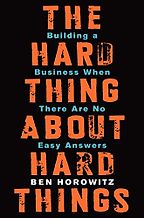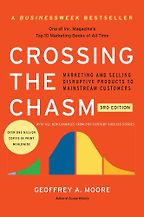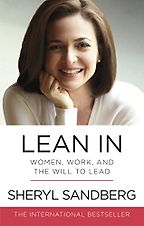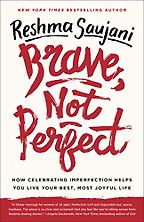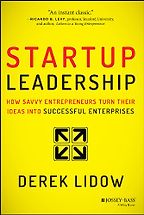Your first recommendation for the best books on running a business is The Hard Thing About Hard Things by Ben Horowitz. What do you like about this book, and why is it a good read?
For me, this book is a paean to founders, about the mix of practical skills and emotional resilience you need to start and run a company. Ben Horowitz is legendary these days because, along with Marc Andreessen, he was the co-founder of Andreessen Horowitz, which is probably the most important venture capital fund in the world. But when he wrote this book, he and Marc had been through a rollercoaster at a company called LoudCloud.
LoudCloud was the innovator of this idea of putting servers ‘in the cloud’ where everybody could use them. It changed the internet—these days, Amazon, Google, and Microsoft all run massive cloud businesses. Unfortunately, LoudCloud was a horrible failure because all their customers were startups, and when the dot com crash happened all their customers went out of business leaving them with data centers full of servers that nobody was going to pay for. They managed to sell the cloud business for almost nothing and started selling the software they used to manage those servers. They barely stayed alive but finally went on to sell to HP as a software company. It’s a legendary pivot.
Through this process Ben, as CEO, learns incredibly hard-fought management lessons. He starts sharing them on his blog. It’s things like: ‘How do you hire an executive?’ ‘What do you need to interview for?’ or ‘I hired this person who came from a big company and within days of joining my little startup he was rejected by the system—total culture clash. How do you avoid that?’ Eventually, he decided to turn the blog into this book.
One thing Ben captures that every entrepreneur will identify with is the emotional journey of a founder. Ben says that there are only two emotions a founder experiences: terror and euphoria, often at the same time. And it’s true!
Another great concept he shares in the book is about the entrepreneurial mindset. The probability that any startup will succeed is extremely low. If you just look at the statistics, you’d be crazy to launch a startup. But startups aren’t statistics, they’re calculus: there is an answer, and you just have to find it. Your job is to be the one in a hundred. In other words, this isn’t a random chance: you can figure it out—and if you don’t, you will be a statistic!
To be an entrepreneur you have to be almost strategically irrational. He doesn’t say crazy, but he does say there’s an irrationality in believing that you can find that one out of a hundred. You also have to be deeply pragmatic about this, and that’s why there’s euphoria and terror at the same time—because what if you don’t find it? Ben even makes this emotional rollercoaster into a graph: you feel good for a while, and then horrible for a while because you learn something or the market changes.
“If you just look at the statistics, you’d be crazy to launch a startup”
When I was starting AppNexus I had the chance to meet Marc and Ben, before Andreessen Horowitz, when they were still at HP after the sale. I pitched my big idea—a cloud computing platform for advertising—and at the end they looked at me and said, ‘This is a terrible idea. We tried this at LoudCloud. You don’t have enough money to compete with the big guys like Amazon. They’ll crush you with their access to capital.’
So I said, ‘Okay, thanks for meeting me.’ And they said, ‘No, no, we want to invest,’ and I was like, ‘Why would you want to invest after telling me that?!’ And they said, ‘Well, most people walk in and are optimistic as all hell, saying ‘this is going to be the biggest business of all time.’ But you walked in and told us you know how difficult this is all going to be. The people who think it’s going to be great, when they hit the hard things and it turns into a struggle, don’t know what to do. You’re telling us you’re ready for it to be a struggle from day one. That’s the mindset of great founders—they’re built for and build for the struggle.’ That is the mindset of this book: starting a company is about the inevitable hard things, and if you’re willing to go through it, and you have the skills to learn and do all the things, you’ll find a way.
By the way, Marc and Ben were right: my cloud computing concept was a terrible idea. We pivoted, though, and found a better business, and AppNexus was a huge success.
How much do you think being a good business leader is about this emotional self-awareness?
I think self-awareness and this deep ability to handle big and often conflicting emotions at the same time is critical. You’re going to be afraid, and if you’re not then you’re doing something wrong. And sometimes you’re going to be euphoric, and if you’re not you’re definitely doing something wrong! But you can’t get pulled too far in either direction.
There’s a great book by Andy Grove called Only The Paranoid Survive, which we won’t talk about, but that’s the idea: that there is a certain level of paranoia you need to have every day but you can’t let it overcome you, or no-one will do anything. This is what it feels like to be an entrepreneur.
Let’s segue from there to your second book for people running businesses, which is Crossing the Chasm: Marketing and Selling Disruptive Products to Mainstream Customers by Geoffrey Moore. Please tell us more about this book.
This book, and there’s a sequel called Into the Tornado, are the operating manual for how to introduce a product into a market. He wrote this book in the 1990s, before the internet bubble. The examples are products like hard drives, so not super applicable today, but the book still is.
He says that we traditionally have thought of product adoption as a bell curve; there are bleeding-edge adopters at the edge, then there are pragmatists who wait till everyone else does it, and then there are late adopters. You start at one side and gradually build your way up the curve.
The hypothesis of this book is that this is not true. There are bleeding-edge people who will try something brand new, but then there’s a chasm: a gap between these buyers and the next set of early adopters. This chasm, where you can’t find anybody to buy your product, is dangerous for many reasons. Does it mean your market is too small? Do you have the wrong product? Moore says the key is to understand why these buyers are so different from each other and what you have to do to get across the chasm to the early adopters.
Where Ben’s book talks about the emotional journey of getting through the chasm, Crossing the Chasm is about strategies to identify and understand different types of customers and how they think about and buy products. Into the Tornado says, ‘Then what? How do you get from early adopters up and over that curve to all the money?’—because you don’t really make money until then.
I walked around at AppNexus for years with Into the Tornado in my backpack. I’m going to be honest, I didn’t recommend Into the Tornado because I never finished. I’d open it and go, ‘Oh, that’s such a good idea, I have to go do that!’ and put it back into my backpack. I think I’m still on chapter eight.
Crossing The Chasm is one of those books that has really deep insights about how businesses, especially, buy products, the people who work there and what motivates people and companies. It really gets at this idea of strategy. There are so many successful startups, they can’t all be doing something different. There’s a playbook here, deeper ideas that we can pull into any industry. Venture capitalists are great at pattern matching and this playbook is a core part of it: ‘We can see the signs, we can feel it, we can think about how much capital we need, we can think about the talent.’
There are so many interesting books about the early startup and how to get through that early adopter phase. Another book I thought about including was The Four Steps to the Epiphany, which is another framework for this. It talks about customer development as this idea of, ‘how do you find the customer?’ You don’t build a product and then look for customers, you find the customer and build them the product.
Building a business is an incredibly practical thing. How does the theory that you find in a book interact with the actual running of the business? How do you feel about business books as a whole?
In general, I’m very sceptical of business books. With a lot of them, there is one idea in the book. One of my favourites is called What Got You Here Won’t Get You There. I’ve never opened it, but I feel the title says it all. The basic idea of the book is that all the things that made you successful to get to the point where you are, you will have to relearn and do something different. If you were super scrappy and got your hands into every line of code, that won’t work if you’re running a 300-person company. It’s a very meditative, Buddhist idea, treating every step as brand new. Walk in with a beginner’s mind. (I assume that’s what it says, because I haven’t read it).
For me, there are a few benefits of business books. One is a common language with a team around how to talk about things. For example, Ben has an idea of a wartime CEO and a peacetime CEO. That’s a really important concept. What does it mean to be at war? It means only the most important thing matters. We’re not going to worry about developing teams and all the cultural things: we have a crisis and we have to fight it. But in peacetime, we should be thinking about how to build the foundations, the culture, the process, and think about values. It’s a different way of being, a different attitude.
That’s powerful not just as a lesson for a CEO but as a way to talk to a management team. “Guys, gals, we’re transitioning! We were in this wonderful place where we were just able to build, but now…WE’RE GOING TO WAR!” It’s a very violent metaphor he uses, but I think it’s valuable.
For Crossing the Chasm, at my current company Scope3, we sold three deals in rapid succession just three months after starting the company. We were so excited… and then we didn’t sell anything for three months. We were kind of freaking out! ‘What are we doing wrong? Why can’t we find anyone to buy our product?’
Five Books interviews are expensive to produce. If you're enjoying this interview, please support us by donating a small amount.
I realized that we were in the chasm. We found the companies that believed in us and our vision, and they basically bought vapour. They were validating that we were building the right thing, and they gave us the feedback and the confidence to get through to the next set of customers. But most people aren’t going to buy vapour. Those first customers are so valuable to any company, and they got us through, but knowing there is a chasm lets you ask, ‘Why is no one buying our vapourware?’ Because no one’s crazy enough, except those first awesome believers. I’m sure Gurman (thank you!) will read this and think, ‘What? I bought vapour?’
That, to me, is the power of these books. They help the people who are in and around the company, whether an investor or a board member or a potential employee, ask the right questions about the traction a company is getting. They help the team to have a shared framework to understand that early adopters are going to want some proof and see some real data and product. You’ve seen the TED talk of the guy dancing by himself, but when the second person joins the dance, that makes it a dance. That’s the early adopter. As soon as a few people join, everybody joins.
Crossing the Chasm helps entrepreneurs contextualize and strategize through a critical time in a company’s lifecycle. It’s required reading for anybody starting a tech company.
The next book on your list is Lean In by Sheryl Sandberg; I’m sure a lot of people are familiar with this manifesto on leadership from someone who ran one of the world’s most succesful businesses, but could you tell us about this choice?
I haven’t heard as much about this book in the last few years, but when it came out it was really impactful, not just because Sheryl is incredible, but also because it had some really pragmatic examples and tips for what it means to be a woman in the workplace. More important for me is what it tells us about how to be a man in a workplace with women.
The title of Lean In is based on this moment Sheryl walks into a conference room. The women are at the back and the men are at the table and she’s like, ‘What? Get to the table!’ And the equal and opposite side of this is that men have to make room at the table, physically and metaphorically.
What is our obligation as leaders? To create an environment where women feel they belong, get equal opportunities, and can thrive. This isn’t a passive activity. This is hard work. The world has so many built-in biases toward men that I didn’t notice until I started looking for them.
For me personally, Lean In was the start of my realization that building a great company is more than just inventing products and selling them and being a unicorn. It’s also taking a hard look at how the leadership team acts, including the board. Are there women in the room? Are they first-class citizens? Are we promoting women the right way? Are women getting opportunities for special projects, for speaking engagements? And on and on. All of this is foundational cultural change and requires convincing men to lean into this work.
So Lean In began years of evolution. We’re not there yet. I don’t think men are doing enough. We’ve opened some doors but there are lots more to open. Anyone in a leadership role, especially in technology companies, needs to read this book and others like it that talk about how it feels to be a woman at work and then do something about it.
I’ll give you a concrete example of this. At AppNexus, I realized that I was mentoring some men and some women, but I kept hearing that it was harder for women to find mentors and get to work on special projects. So I decided to only mentor women on the thesis that men had plenty of opportunities, and that this would have the most impact and maybe set an example for others to check their own biases too. It turned out to be a huge educational experience for me because I got to understand so much more about what it’s like to be a woman in my own organization.
I credit Lean In for making a lot of these issues mainstream. There are other great books, but for me this one started my journey towards wanting to be a much more aggressive ally for women and for nurturing women leaders.
Lean In built a movement around the book, and was really deliberate about starting conversations and it became a focal point for a lot of these conversations. Can you speak to the way a book can be a movement starter, as well as just something that we read individually?
I think that’s one of the powerful things about books. Lean In did completely change the narrative. We’re a memetic society, memes are powerful, we all want to be like each other in some way. I do think it gave us an opportunity to be part of something.
Going back to Crossing the Chasm, in a way we jumped across with that book. It’s not a side thing anymore. If you’re a leader and you’re not actively focusing on gender issues, you’re behind the curve and putting your business at risk. Your board is reading Lean In, your team is reading Lean In, your potential employees are reading Lean In.
It’s why newspapers are great. If you’re not reading the New York Times today, then you’re missing out on all these stories. If you’re not subscribed to The Browser, if you’re not reading Five Books, you’re missing out. I sound really smart in meetings because I read them!
Lean In did that on a massive scale. The entire corporate world was listening to Sheryl Sandberg. That was an incredibly powerful step forward, a big step change for an industry that wasn’t going fast enough (and still isn’t!).
Your next selection for us is Brave not Perfect by Reshma Saujani. She’s the founder of Girls Who Code. Please tell us a bit about why you chose this book.
Reshma starts this book with her ‘perfect’ story. She’s a South Asian American who went to Harvard, then Yale Law School, and then on to a series of prestigious jobs. Everything she’s done is in the service of being perfect, but she’s never really taken a risk.
Then, at 33, she does something incredibly brave. She runs for Senate and gets crushed. All of a sudden, for the first time, she has not only taken a risk, but she has failed. Publicly, and big time. So what does she do next?
A few months after her Senate campaign (which, as a friend of her husband, I had supported), she called me and asked for a favour. She was working on an idea to start an organization that would help girls learn to code in high school, to start to destigmatize the idea that technology is for men. She asked if we could spare some office space for her burgeoning organization, and I said yes.
That organization was Girls Who Code, which has now introduced hundreds of thousands of girls and young women to programming and technology. They have helped make technology something girls believe they can do and we now have computer science programmes in college that are more than 50% women. At Princeton, computer science is now the largest major. That’s incredible. Think about the impact now, ten years later, of Reshma’s bravery—not just of starting the organization but of making phone calls to people she barely knew, asking for help.
Reading this book reminds us that women are often held to an unreasonable standard of perfection. Going back to entrepreneurship, both for Brave not Perfect and Lean In, these are successful, brilliant women helping us understand what it feels like to be a woman in business and how brave you have to be and how hard it is to get a seat at the table. I think that’s really inspiring for me personally, but also for a lot of women who are afraid of taking that step and doing something out of the box.
Reshma’s now stepped down as CEO of Girls Who Code to start an organization called Moms First, fighting an even harder battle around getting childcare for all in the United States. Unlike many other democracies, we dramatically underfund childcare, something moms need to be successful at work. When companies don’t support childcare and parental leave, they’re not supporting women. That support isn’t just financial, it’s also about a culture that puts moms and families first. If you take one thing away from this interview, it’s that building a great company means making everyone successful at work—and especially women.
I think there’s a link back to the Hard Thing about Hard Things in terms of willingness to persevere with a seemingly impossible thing.
Yes, can you imagine starting a programme like that, that goes national and has tens of millions of dollars of funding? It’s an incredible achievement. It’s the same impossible thing that Ben would have looked at and said, ‘You’ve got a one-in-a-thousand shot at success.’ And she did it.
How much justice do you think there is in which organizations end up succeeding?
I think our society has a deep justice problem. I don’t think there’s a lot of justice in the sense that as a white, cis, straight, tall, middle-class, college-educated man with two parents, I have all the advantages in terms of starting a company. Where does funding go? It goes to white men, to be honest. When you join a company, odds are if you join a company run by a white dude you’ll get more money and more chances, and that becomes a cascading advantage throughout a career. Men get promoted more, especially tall white men.
I don’t think there’s justice in that. Now, if you’re comparing two tall white men, and asking, ‘Who’ll have the better chance?’ I do think grit, self-awareness, emotional maturity, technical knowledge and those things play into it. But I don’t think many people would say there’s justice in the way we run an entrepreneurial system.
It’s why I want to highlight people like Sheryl Sandberg who, while one of the most successful women in the history of technology, was not the CEO of Facebook. And I want to highlight Reshma, who is one of the most impressive and influential women in and around the technology sector. She should be a household name even though her organizations are non-profits and not worth billions.
A world where women raise 50% of venture capital and have 50% of board seats and are 50% of the CEOs of public and private companies—that would be justice. Or at least a start.
The last book you recommended for people running a businesss is Startup Leadership by Derek Lidow.
Derek is a professor of entrepreneurship at Princeton University’s Keller Center. I met him because his son worked at AppNexus and he invited me to speak at his class called “Entrepreneurial Leadership.” I went down to Princeton and gave a lecture called “Three Failures and a Big Success,” about how my first three businesses after college were failures. I got fired, I was unemployed, and had a dismal experience for my first few years. Finally, I hit it big and founded a company called Right Media which was extremely successful and sold to Yahoo for a lot of money.
The reason I love him and his class and his book is because he talks about the skills you need as a leader to be a founder and an entrepreneur. He has some really basic ideas. You have to understand the firm and have almost a mental model of how the company works. What do people do? Your job is not just to envision a product, it’s to envision an organization. How do you think about an organization?
If you’re a college kid and you’ve never started a company, you might have a great product, but how are you going to think about the people and the org chart and the processes and how they interact and the management structure? You need to understand people and how they work together at scale in business. The mental model of the firm, and how that changes and evolves over time, is a critical lesson from this book.
Another key lesson I love and that I still use with my teams is the difference between a process and a project. A process is something that you do repeatedly forever, and a project is something with a start and an end. His point is that companies are built on processes, and the only way to create a new process is to start a project to stand it up. He also argues that all processes regress to the mean over time. This is a key insight for people who are building companies, especially as they move through their lifecycle.
Derek lays out four lifecycle phases:
In phase one, you’re scrappy and trying to find product-market fit. Is this product something people will buy? You don’t have any processes, you don’t need any processes, it’s all a bunch of projects.
Then the next phase, you’re trying to put some process in place: can we repeatedly sell this, can we find customers in a structured way?
In stage three, it’s mainly process. As the founder, you’re no longer searching for customers, you’re no longer this amazing entrepreneur. You’re a manager. You’re running a mainly process-driven company that is the opposite of what it was at the beginning, which was the scrappy little rowboat. Now you’re running an ocean liner. Maybe people are getting food poisoning! You have to deal with tons of overhead and meetings and budgets. Why do we think this same person will be good at pulling the oars as will be great at sitting at the helm of this massive money-making machine, and what does that mean for us as leaders?
In stage four a company starts fragmenting into different business units, either through acquisitions or innovation, and might get scrappy again at scale or slow down and get so process-driven that it stops innovating altogether. Few companies get this far—and even fewer founding entrepreneurs.
The final point about this book is how much Derek talks about self-awareness. Imagine taking this class at Princeton. These are kids who’ve never failed. They’re brilliant, probably all play four sports, three instruments, and write in Latin. And you take this class where a key lesson is that if you want to be an entrepreneur, you’re going to fail. A lot.
Being ready for that failure and learning from it and understanding yourself emotionally is at the heart of leadership. It’s not about being the smartest person in the room. It’s about knowing yourself, and understanding basic ideas about how companies work and how people succeed. It’s about understanding how you interact with different people differently. It’s a lifelong journey about people. I just love that.
I highly recommend this book. It’s about leadership and is critical reading for anyone who wants to understand the skillset and the core concept of ‘What is a startup?’ and ‘What is a leader of a startup?’
You asked what the point of business books was. I think the point of business books is that millions of people have gone before you. This is not a new journey that you’re embarking upon. I don’t think you can learn entrepreneurship or leadership in a classroom, it’s something lived. As you’re living it, books are amazing, because just like carrying Into the Tornado in my backpack, every time you open one of these books you feel this knowledge coming in from people who’ve gone before. It’s kind of a real-world school. You’re able to pull these ideas into your everyday experience in a way that is deeply meaningful. I don’t think reading them in a classroom would be anything like reading them through that journey. These are lived texts, if that makes sense.
Interview by Uri Bram
March 18, 2023. Updated: December 5, 2023
Five Books aims to keep its book recommendations and interviews up to date. If you are the interviewee and would like to update your choice of books (or even just what you say about them) please email us at [email protected]
